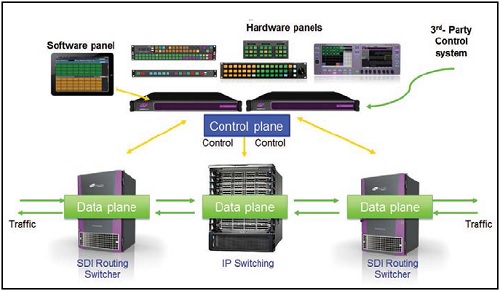A Software-Defined Future for Broadcast?
OTTAWA—Broadcasters are starting to embrace video over IP using software-defined networks, virtualized cloud processing, and software-defined infrastructure. Entire production operations spanning the creation and management of broadcast-specific acquisition, editing, playout and distribution/storage functions are now using specialized software running on servers and in the private/public cloud. In doing so, these broadcasters are moving away from dedicated, broadcast-only proprietary hardware such as audio/video switchers, traditional editing suites, and signal routers.
On a larger scale, they are taking the first steps towards making traditional master control rooms obsolete.

Grass Valley’s GV Convergent SDN control system transparently manages facility routing as the industry migrates from SDI to IP infrastructures.THE END OF ‘BIG IRON’
Case in point: Disney/ABC Television Group is moving its broadcast playout, network and delivery infrastructure into the cloud using Imagine Communications’ VersioCloud, an IP-enabled, integrated playout-in-the-cloud platform. In the simplest sense, Disney/ABC personnel will be able to perform their functions using IP-connected desktop PCs, rather than working in traditional master control facilities. “By leveraging evolving IP and cloud technologies we are able to move beyond what’s currently possible with traditional proprietary ‘Big Iron’ broadcast infrastructures,” said Vince Roberts, chief technology officer and executive vice president of Disney/ABC Television Group’s Global Operations.
Fox Networks’ Engineering & Operations is actively experimenting with SDNs, including the seamless switching of uncompressed broadcast signals using SDNs and commercial-off-the-shelf Ethernet switches and servers. Fox Sports has gone one step further by deploying Game Creek Video’s “Encore” production mobile, which is equipped with Evertz IP-enabled gateways and router to carry and switch more than 6,900 IP-based video channels.
“We are looking to SDNs and IP in general to create flexibility in our broadcast plant,” said Thomas Edwards, vice president of engineering and development at Fox Networks Engineering and Operations. “Being able to spin new channels up and down using software on COTS hardware and the cloud, rather than having to build or reconfigure physical master control production facilities, will allow us to field new services far quicker and much more inexpensively,” he said. “This is vital, because we’re going to have to be a more agile broadcaster in order to stay competitive in the future.”
The trend towards SDNs in specific, and software-defined infrastructure in general, is readily acknowledged by equipment suppliers such as Dallas-based Imagine Communications. “We foresee the day when our broadcast customers are buying COTS data equipment from IT companies such as Arista, Cisco and HP, and we are providing the broadcast-specific software that run on these systems, alongside traditional SDI-based equipment,” said John Mailhot, systems architect for IP convergence at Imagine. “That’s why we’re not competing with those suppliers; we’re forming strategic partnerships with them.”
Grass Valley is also onboard the SDN train with the company’s GV Convergent SDN control system software. “Broadcasters see the value in moving from SDI to IP, with the tremendous potential of saving infrastructure cost,” said Louis Caron, GV Convergent SDN product manager for the Montreal-based provider of broadcast and production technology. “GV Convergent SDN provides a technology-agnostic operation paradigm requiring no additional training for the operators when migrating to an IP infrastructure,” he said. GV Convergent SDN is currently being tested by selected broadcasters according to Caron.
Get the TV Tech Newsletter
The professional video industry's #1 source for news, trends and product and tech information. Sign up below.
VIRTUALLY SPEAKING
Despite the introduction of SDN products by Grass Valley and Imagine Communications, media consultant Al Kovalick believes that these vendors’ clients have yet to fully embrace the full potential of SDNs and software-defined infrastructure.
“The problem is that most broadcasters are comfortable with the industry-specific proprietary technology they are accustomed to, and scared of moving into SDN, COTS data centers and virtualized production in the cloud,” said Kovalick, founder of Silicon Valley-based Media Systems Consulting, and TV Technology’s cloud columnist. “They just don’t grasp how much is possible by moving to a true software-based production model—and how much money they can potentially save.”
This possibility is not lost on Lawrence Kaplan. The co-founder of Omneon Video Networks recently launched the SDVI, an IP-focused SaaS company that provisions/ manages virtualized production applications for media clients; both on their premises and in the cloud.
According to Kaplan (who serves as SDVI’s president and CEO), broadcasters who cling to traditional forms of video production/ playout are “wasting” millions of dollars, because such functions can be done much less expensively using a virtualized broadcast facility. Those broadcasters who migrate to SDN by building in-house data centers could also be wasting money, “because such 24/7 facilities tend to be at peak usage 25 percent of the time, at most,” he said. “The rest of the time, you are paying for capacity that isn’t making you money.”
Whatever the economics, broadcasters are likely to take their time moving to SDN-based production/playout; in part because this paradigm shift will have such an enormous impact. “Think back 40 years, when broadcasters were still using 2-inch Quad tape and CRTs,” said Fox’s Edwards. “Broadcasting has changed radically since then, but the biggest changes—such as SDNs, virtualized production/playout, and software-defined infrastructure—are just starting to occur now.”
James Careless is an award-winning journalist who has written for TV Technology since the 1990s. He has covered HDTV from the days of the six competing HDTV formats that led to the 1993 Grand Alliance, and onwards through ATSC 3.0 and OTT. He also writes for Radio World, along with other publications in aerospace, defense, public safety, streaming media, plus the amusement park industry for something different.

